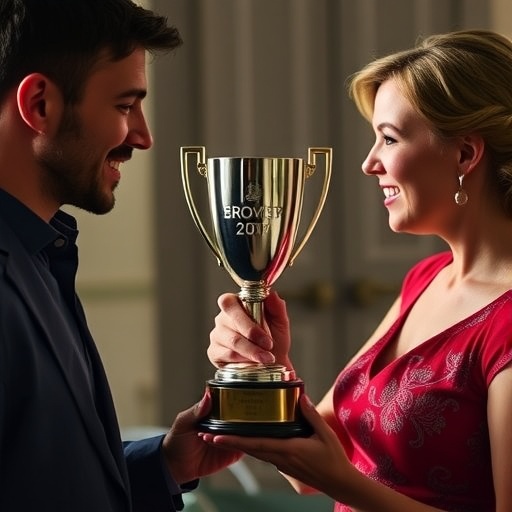New research emerging from the University of Bath School of Management has profoundly reshaped long-standing assumptions about the dynamics of marriage, particularly the famed “trophy spouse” phenomenon. Traditionally understood through a gendered lens, this phenomenon posits that men seek physical attractiveness in their partners, while women prioritize financial resources and social status. Popular culture has perpetuated this idea through the stereotype of the “trophy wife,” a woman embodying physical beauty in exchange for a man’s elevated social standing. However, the latest empirical study reveals that this exchange between attractiveness and status is far more nuanced, symmetrical, and dynamic, persisting and evolving long after the wedding vows are exchanged.
The study, conducted by Dr. Joanna Syrda and her team, challenges the conventional wisdom that the marriage contract fixes these social and physical exchanges at inception. Instead, the findings show that spouses actively and continuously renegotiate this balance throughout their married life. The research meticulously analyzed two decades of data from more than 3,700 heterosexual dual-earner couples in the United States, focusing on how changes in the wife’s proportion of household income affected both partners’ body mass index (BMI) and physical activity levels.
Intriguingly, the analysis revealed a bidirectional pattern: when a wife’s income share increased, her husband tended to lose weight and increase physical activity, effectively enhancing his physical attractiveness. Conversely, when a husband’s earnings rose, the wife was the one who adopted healthier habits and became slimmer. This reciprocal adjustment dispels the myth that only men’s status affects women’s beauty maintenance, highlighting an evolved, equitable relationship paradigm where both partners respond to shifts in economic power by modifying their physical presentation.
This phenomenon can be interpreted through the lens of evolutionary psychology and social exchange theory, but with modern adaptations. While traditional theories emphasized gender-specific motives—men pursuing fertility signals and women seeking resource provision—modern couples navigate a more complex interplay of mutual status concerns. Dr. Syrda likens marriage to a “repeated game,” where each partner constantly weighs the costs and benefits of remaining in the union, adjusting their investments in fitness and appearance to sustain perceived fairness and desirability.
The research methodology is grounded in robust statistical analysis of longitudinal data, enabling the researchers to control for a variety of confounders and isolate the nuanced effects of income trajectories on physical health indicators. By linking changes in financial contribution with BMI fluctuations and physical activity, the study concretely demonstrates that marital dynamics are not static but fluid and responsive to socio-economic shifts. The findings emphasize that individuals do not merely accept shifts in marital power imbalance passively; rather, they engage in active compensation strategies to preserve relational equilibrium.
Moreover, the cultural context surrounding these behaviors is undergoing a seismic shift. The rising prevalence of households where wives earn equal or more than husbands has catalyzed a redefinition of masculine and feminine roles within marriage. This shift is accompanied by burgeoning male grooming markets, the rise of fitness influencers targeting men, and the destigmatization of men’s engagement with skincare and body image. The research attributes these cultural markers as tangible evidence of increasing aesthetic parity between genders, reflecting a broader trend towards equality not just in financial terms but also in physical self-presentation.
From a societal perspective, the study also illuminates how significant discrepancies in spousal income without concurrent adjustments in fitness and appearance can precipitate relationship instability. Dr. Syrda underscores that failure to recalibrate desirability metrics may exacerbate tensions, potentially increasing the risk of marital dissolution. This finding situates physical self-maintenance behaviors as not merely individual health choices but as integral components of relational negotiation strategies.
While this study primarily focuses on the statistical patterns underlying beauty-status exchange within marriage, it leaves open the intriguing question of conscious versus unconscious motives. Are partners deliberately managing their physical attractiveness in response to economic shifts, or do these changes happen more subtly, influenced by social conditioning and implicit psychological mechanisms? This is an area ripe for future research, promising deeper insight into the interplay between cognitive processes and relationship dynamics.
The practical implications of these findings extend into fields such as psychology, economics, and public health. Understanding this ongoing negotiation process can inform therapeutic approaches aimed at relationship counseling, emphasizing the importance of mutual recognition of shifts in economic power and corresponding changes in appearance-related self-investment. Additionally, policymakers and social scientists investigating gender roles and marital stability can benefit from integrating these insights into broader frameworks addressing equality and family welfare.
The University of Bath’s contribution to contemporary social science through this study exemplifies the power of multi-disciplinary, data-driven research to challenge entrenched stereotypes. As social norms around marriage continue to evolve in response to shifting economic realities and cultural practices, such evidence-based analyses are invaluable for capturing the complexity and resilience of human relationships in the 21st century.
Ultimately, the “beauty-status” exchange is not a relic of outdated gender politics but a living, adaptive feature of marital life that underscores the partnership’s fundamentally negotiated nature. This research calls for a reevaluation of how we understand attractiveness, status, and equality within intimate relationships, stressing that marriage is a dynamic institution where both partners continuously shape one another’s social and physical identities.
Subject of Research: People
Article Title: (A)symmetries in beauty-status exchange: Spousal relative income and partners’ BMI (at) during marriage
News Publication Date: 10-Nov-2025
Web References: http://dx.doi.org/10.1016/j.ehb.2025.101543
References: Syrda, J. (2025). (A)symmetries in beauty-status exchange: Spousal relative income and partners’ BMI (at) during marriage. Economics & Human Biology.
Keywords: Marriage, Social values




